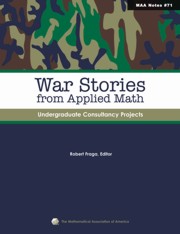Book contents
- Frontmatter
- Contents
- Introduction
- An Industrial Mathematics Program
- Source of Problems: Industrial Contacts
- Panel Discussion Following “Industrial Contacts”
- Course Integration
- The Consortium for Mathematics and Its Applications (COMAP)
- Program Management
- Project Deliverables I
- Project Deliverables II
- Using Projects from Industry to Teach Mathematics and Statistics to Liberal Arts Majors
- Mathematical Modeling in ICIC Projects
- Appendix: A Sample HMC Report
Using Projects from Industry to Teach Mathematics and Statistics to Liberal Arts Majors
- Frontmatter
- Contents
- Introduction
- An Industrial Mathematics Program
- Source of Problems: Industrial Contacts
- Panel Discussion Following “Industrial Contacts”
- Course Integration
- The Consortium for Mathematics and Its Applications (COMAP)
- Program Management
- Project Deliverables I
- Project Deliverables II
- Using Projects from Industry to Teach Mathematics and Statistics to Liberal Arts Majors
- Mathematical Modeling in ICIC Projects
- Appendix: A Sample HMC Report
Summary
Introduction
Since 1990, Indiana University has offered a junior-senior level course which is designed to teach selected students how to use mathematical and statistical techniques to solve real problems and projects presented to them by companies and by units of government. In this chapter we discuss the nature of the course, the types of projects, the mathematical and statistical topics usually taught in the course, and the results of evaluations of the course.
Background and Motivation
The course described in this chapter is part of the Indiana University (IU) LAMP program. The acronym LAMP stands for Liberal Arts and Management Program, and the associated program is designed to provide selected liberal arts majors with tools to help prepare them for a career in business or government. The LAMP program started in 1990 with classes of 25 liberal arts majors per year and it now enrolls about 100 students per year. Students typically enroll in the program at the start of their second year on campus, and most have majors that are not in the sciences or any traditional quantitative field. Planning for the program included a special course to provide these students with quantitative tools that were not normally part of their degree requirements but which would be valuable in seeking and holding a job in industry. Two IU faculty members, myself, Daniel Maki, in the Mathematics Department of the College of Arts and Sciences and Wayne Winston in The Kelley School of Business, proposed a course in which the key focus would be student teams working with an industry client on a project which would require the students to learn and apply mathematical and statistical techniques.
Information
- Type
- Chapter
- Information
- War Stories from Applied MathUndergraduate Consultancy Projects, pp. 99 - 104Publisher: Mathematical Association of AmericaPrint publication year: 2007
